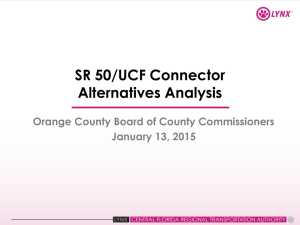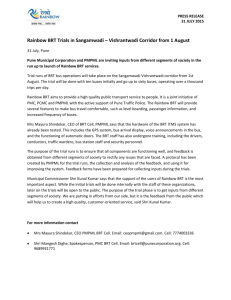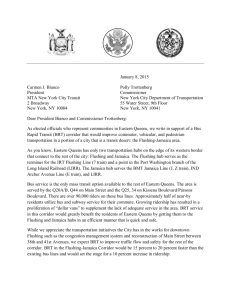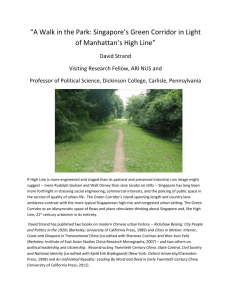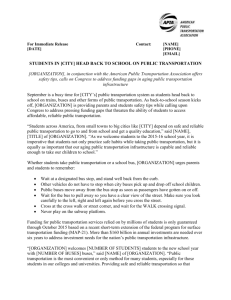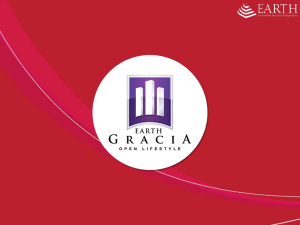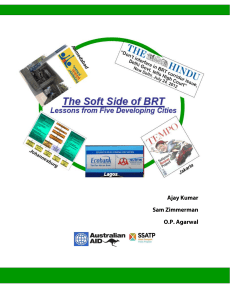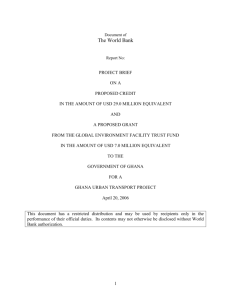PRESS CLIPPING-2 In 3 months, Ahmedabad BRT a winner Source
advertisement
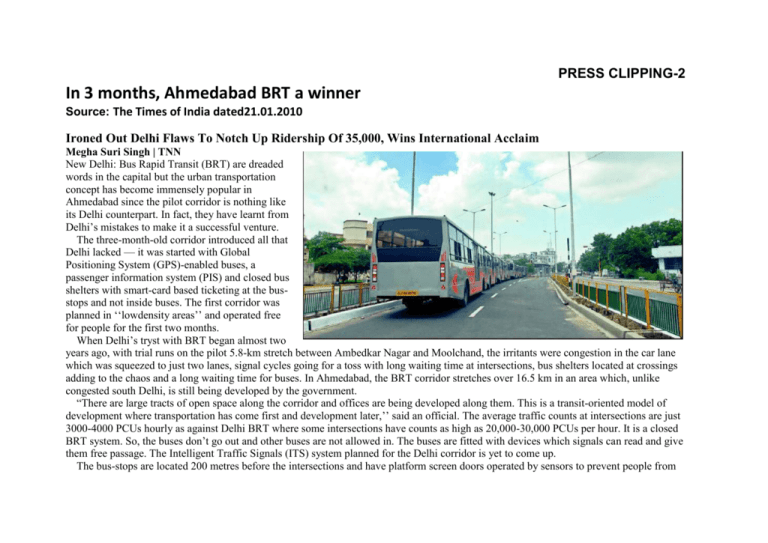
PRESS CLIPPING-2 In 3 months, Ahmedabad BRT a winner Source: The Times of India dated21.01.2010 Ironed Out Delhi Flaws To Notch Up Ridership Of 35,000, Wins International Acclaim Megha Suri Singh | TNN New Delhi: Bus Rapid Transit (BRT) are dreaded words in the capital but the urban transportation concept has become immensely popular in Ahmedabad since the pilot corridor is nothing like its Delhi counterpart. In fact, they have learnt from Delhi’s mistakes to make it a successful venture. The three-month-old corridor introduced all that Delhi lacked — it was started with Global Positioning System (GPS)-enabled buses, a passenger information system (PIS) and closed bus shelters with smart-card based ticketing at the busstops and not inside buses. The first corridor was planned in ‘‘lowdensity areas’’ and operated free for people for the first two months. When Delhi’s tryst with BRT began almost two years ago, with trial runs on the pilot 5.8-km stretch between Ambedkar Nagar and Moolchand, the irritants were congestion in the car lane which was squeezed to just two lanes, signal cycles going for a toss with long waiting time at intersections, bus shelters located at crossings adding to the chaos and a long waiting time for buses. In Ahmedabad, the BRT corridor stretches over 16.5 km in an area which, unlike congested south Delhi, is still being developed by the government. “There are large tracts of open space along the corridor and offices are being developed along them. This is a transit-oriented model of development where transportation has come first and development later,’’ said an official. The average traffic counts at intersections are just 3000-4000 PCUs hourly as against Delhi BRT where some intersections have counts as high as 20,000-30,000 PCUs per hour. It is a closed BRT system. So, the buses don’t go out and other buses are not allowed in. The buses are fitted with devices which signals can read and give them free passage. The Intelligent Traffic Signals (ITS) system planned for the Delhi corridor is yet to come up. The bus-stops are located 200 metres before the intersections and have platform screen doors operated by sensors to prevent people from getting hit by buses passing by. The doors open when a bus arrives and all buses, standard floor ones, stop in perfect alignment with the bus shelters. Delhi spent much more on buying low-floor buses to provide stepless entry to people, but even two years later, drivers seldom stop the bus in alignment with the platform. ‘‘We started with a ridership of 17,000 people daily in October last year. This has grown to 35,000 in three months,’’ said Prof Shivanand Swamy of CEPT University, Ahmedabad, which conceptualised the BRT model. It recently got the Sustainable Transport Award by Institute for Transportation and Development Policy (ITDP) in Washington. SERVING ITS PURPOSE The BRT corridor stretches over 16.5 km in Ahmedabad and has Global Positioning System (GPS)-enabled buses, a passenger information system (PIS) and closed bus shelters with smart-card based ticketing at bus-stops and not inside buses. It’s also located in an area that is not densely populate Moolchand – Delhi Gate BRT to become operational before 2010 CWG The under-construction portion of Bus Rapid Transit (BRT) from Moolchand to Delhi Gate will become operational before Commonwealth Games. Chief minister Shiela Dikshit said on Wednesday that the Detailed Project Report (DPR) for the second corridor from Shastri Park to Karawal Nagar is almost complete too, and learning from their past experiences, has ensured that this corridor would be from the South Delhi one. ‘‘The construction of the remaining part of the pilot BRT corridor is complete. It will be started soon, well before Commonwealth Games. The other corridor from Karawal Nagar to Shastri Park will also come up soon,’’ said Dikshit, at the sidelights of a symposium on BRT systems organized by Delhi Integrated Multi Modal Transit Systems on Wednesday. She added that the next BRT corridor will be constructed keeping in view the experiences and feedback received from all concerned sections as BRT is ‘‘bound to cater to local needs’’. The new corridor is being planned on the eastern side of Yamuna pushta. The 8.65-km long corridor was initially planned from Shastri Park to Karawal Nagar, which has now been extended to Usmanpur. ‘‘The corridor is expected to be used by a population of about 5 lakh people, of which a majority have an of less than Rs 5,000 per month. The number of cars are also lesser than the average in Delhi. Now, we have proposed to extend the corridor from Karawal Nagar to Gandhi Nagar and add another link from Bhajanpura to Mori Gate to it,’’ said Alok Bhardwaj, Head of Transportation Planning, DIMTS. The corridor is expected to carry about one lakh persons per day as per ridership studies. Learning from the first experience, bus lanes from both directions will be located on one side of the road and pedestrian footpaths and cycle tracks are being provided to cater to the heavy rush of nonmotorized vehicles and people. The bus shelters will be closed, unlike the ones in the pilot corridor, and systems like off-board ticketing based on smart cards, passenger information system (PIS) and in buses will be fitted before the corridor starts. The government seems to be learning from the BRT fiasco. Delhi transport commissioner RK Verma said BRT was a concept that Delhi government had turned down at first. ‘‘If we want BRT to become successful, we need to adapt it to the needs of people in the area where it is being implemented.’’

